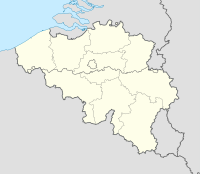| Action of 22 October 1917 | |||||||
|---|---|---|---|---|---|---|---|
| Part of the Third Battle of Ypres of the First World War | |||||||
 Front line 22 October – 6 November | |||||||
| |||||||
| Belligerents | |||||||
|
|
| ||||||
| Commanders and leaders | |||||||
| Douglas Haig | Crown Prince Rupprecht | ||||||
| Units involved | |||||||
|
Fifth Army French First Army | 4th Army | ||||||
| Strength | |||||||
|
3 British divisions 1 French regiment | |||||||
| Casualties and losses | |||||||
| British: 479 | 125 POW | ||||||
Poelcappelle (Poelkapelle), a village in the Belgian province of West Flanders | |||||||
The action of 22 October 1917 was an attack during the Third Battle of Ypres in the First World War by the British Fifth Army and the French First Army against the German 4th Army. British attacks had been repulsed at Passchendaele by the 4th Army at the Battle of Poelcappelle (9 October) and the First Battle of Passchendaele (12 October). While the British waited for another dry spell and the completion of plank roads up to the new front line, the Canadian Corps and fresh British divisions were transferred to Flanders by the British Expeditionary Force (BEF).
The Fifth Army planned an attack to capture the rest of Polecappelle and to close up to Houthulst Forest, while the French 36er Corps d'Armée on the left attacked simultaneously. The plan was for the Fifth Army to provide a defensive flank for the Second Army and to keep pressure on the defenders. It was important to prevent the Germans from transferring troops from Flanders against the French during the Battle of La Malmaison on the Aisne (23–27 October) and to stop local redeployments before the Canadian attack towards Passchendaele, due on 26 October.
On 22 October, the 18th (Eastern) Division attacked the east end of Polecappelle, the 34th Division attacked further north, between the Watervlietbeek and Broenbeek streams and the 35th Division attacked northwards into Houthulst Forest, supported by an attack by the right-hand regiment of the French 1st Division. Poelcappelle was captured but the attack at the junction between the 34th and 35th divisions was repulsed and German counter-attacks pushed back the 35th Division in the centre. The French regiment captured its objectives and later sent parties to scout the southern edge of Houthoulst Forest and take crossings over the Corverbeek on the left flank.
Attacking on ground cut up by bombardments and soaked by rain, the British struggled to advance in places and lost the ability to move quickly to outflank pillboxes. Troops of the 35th Division reached the fringes of Houthulst Forest but were repulsed elsewhere. German counter-attacks after 22 October, at an equal disadvantage, resulted in equally costly failures. The 4th Army was prevented from transferring troops away from the Fifth Army and from concentrating its artillery-fire on the Canadians, as they prepared to begin the Second Battle of Passchendaele (26 October – 10 November 1917).
